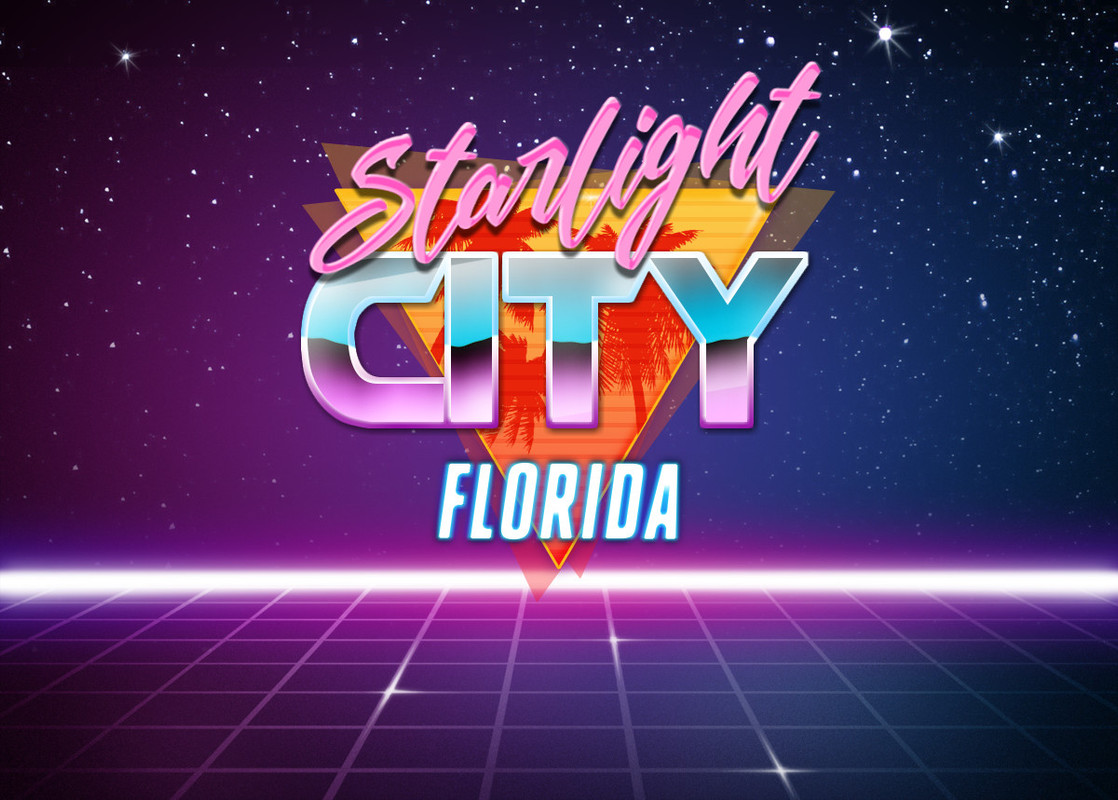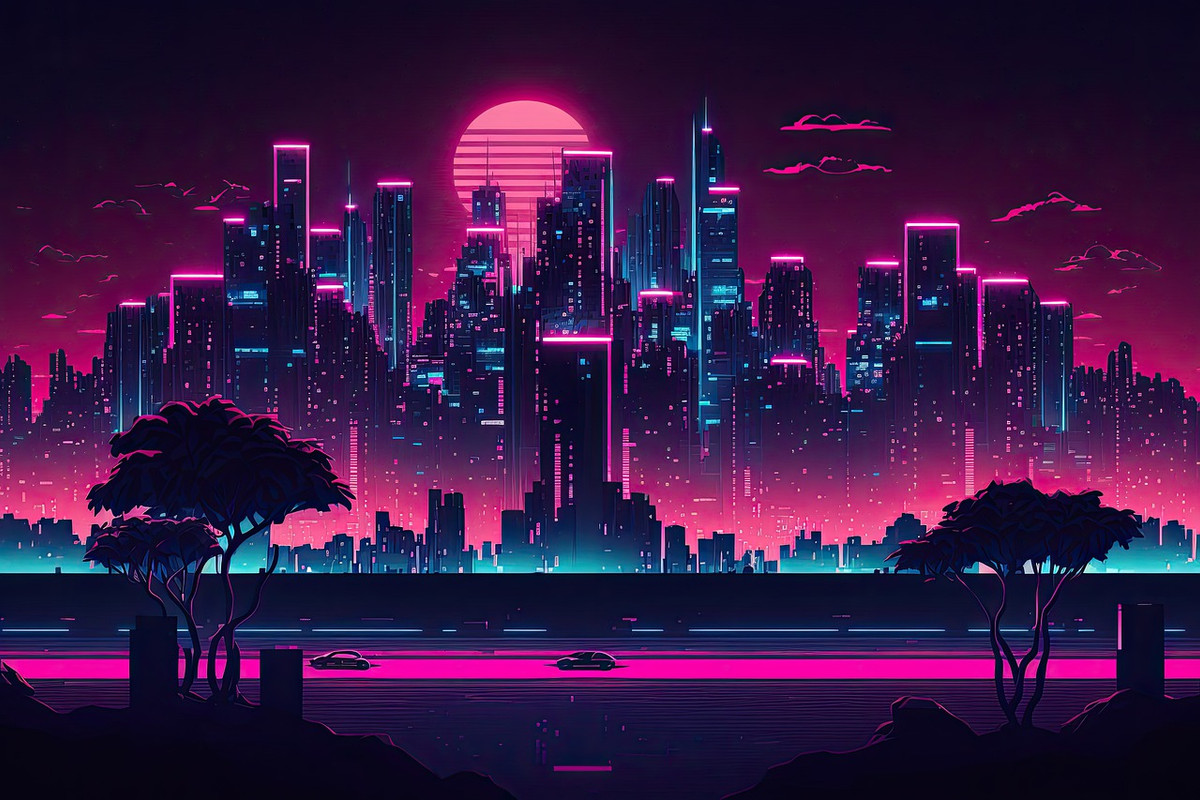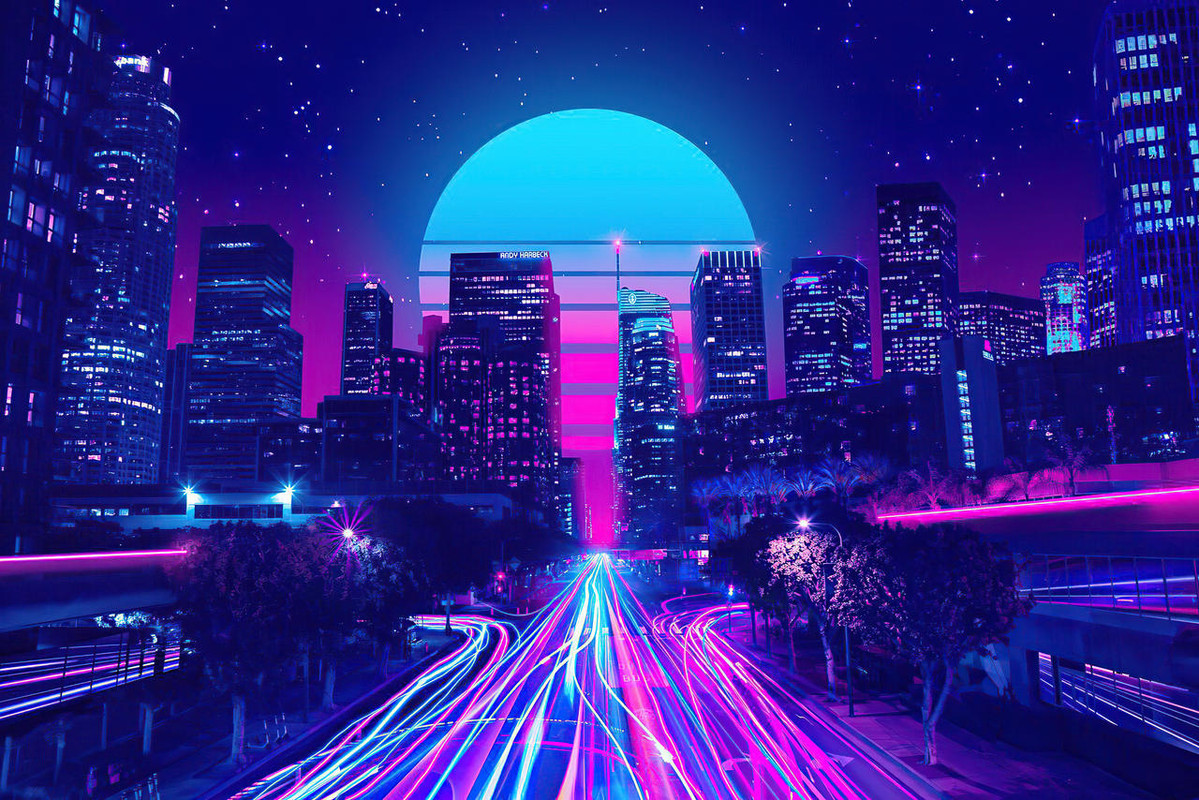Jan 31, 2024 9:49 am

"Where the stars alight, and the future is bright."
— Starlight City Motto
Nicknames: Neon City, Glowtown, The City of Stars, Luminopolis
Population: 445,000.
Total Area: 119 sq mi (191.5 sq km). The metropolitan area is 6,137 sq mi (15,890 sq km).
Average Elevation: 6 feet (1.8 m) above sea level.
Tallest Building: Aurora Tower (868 ft/265 m).
Neighborhoods: Starlight City has 35 neighborhoods.
Income: Median Household: $47,000. 14.5% of Starlight City residents live below the poverty line.
Racial Demographics: Latino: 50.2%, White: 20.4%, Black: 16.3%, Asian: 5%, Pacific Islander: 3.1%, Native American: 2%, Other: 2%.
Religious Demographics: Catholic: 32%, Protestant: 36%, Other Christian Denominations: 12%, Jewish: 9%, Muslim: 1%, Buddhist: 1%, Hindu: 1%, Other Faiths: 1%, Non-Religious: 7%.
Government: Mayor-Commission.
Demonym: Starlighter.
Starlight City is a coastal metropolis and Florida's third largest municipality. It is a major center of finance, culture, arts, and international trade. It is also a significant tourism hub and home to one of the busiest seaports in the country. The city's otherworldly light pollution, a product of its synthwave architectural aesthetics and the strange effects of Vapor, has earned it several nicknames, including "Glowtown" and "Neon City." Though the city proper is not terribly large, it's part of a metropolitan statistical area that extends from Miami-Dade County into Broward County and includes the cities of Miami and Fort Lauderdale.
Starlight City and its suburbs are located on a broad plain between the Florida Everglades to the west and Biscayne Bay to the east. The elevation in the area averages 6 feet (1.8 m) above sea level, especially near the coast. The main portion of the city is on the shores of Biscayne Bay, which contains hundreds of natural and artificial barrier islands. The climate consists of hot and wet summers and warm and dry winters.
Geography
Starlight City is comprised of 35 distinct neighboorhoods, and these can be be grouped roughly into north, south, west, and Downtown areas. The heart of the city is the Downtown, which contains the central business district, as well as major banks, courthouses, offices, museums, nightclubs, restaurants, tourist attractions, parks, schools, and a sizeable residential population. This is also the location of Starlight General (the city's primary hospital) and the main headquarters for the Starlight City Police Department (SCPD).
The southern and western sections of the city are older and contain Glowtown's historic districts. This is also where one finds the city's many ethnic enclaves. Characterized by their strong cultural identity, these residential neighborhoods provide a sense of familiarity and community to the specific ethnicities or nationalities that reside there. With over fifty ethnicities, Starlight City has its fair share of such neighborhoods. While most enclaves represent a diversity of Latin peoples, there are also Chinese, Jewish, and Italian neighborhoods.
North Starlight City is a mix of residential and commercial neighborhoods, as well as some industrial zones consisting of light industrial parks. Most of the residents of these areas are thoroughly working class. Unfortunately, this is also the location of the city's most destitute and crime-ridden neighborhoods. In a few of these locales, the crime rate is much higher than the national average. Among Starlighters, many of the northern neighborhoods have a reputation for being rough and dangerous.

Culture
Starlight City enjoys a vibrant culture that is influenced by a diverse population from all around the world. Due to its geographical proximity to Latin America, the city has a massive Latino community. In fact, people of Latin descent represent roughly half of the city’s total population. Many of these are Cuban exiles who fled to Florida during Castro's revolution in the 1960s, and others are immigrants from Central and South America who came for economic opportunities or to escape political instability. Over the decades, this multicultural environment has made the city a welcoming place for individuals from various backgrounds.
Culturally speaking, Starlight City is known for three things: its cuisine, its music, and its nightlife.
The cuisine in Glowtown is heavily influenced by Latin American and Caribbean cooking. Chicharrón, stone crabs, arepas, churrasco, ceviche, plantains, and Cuban sandwiches are staples of the local diet, in addition to more traditional American Southern foods such as fried chicken, hominy, catfish, and key lime pie. The city is home to a number of iconic Michelin star restaurants but also supports a robust street food scene. Food trucks and street vendors are a common sight on all the main thoroughfares of the city.
Glowtown is a diverse hub of musical styles, though Latin music is preeminent among them. Alongside mainstream pop and dance music, the radios in Starlight City all play a heavy dose of various Latin musical genres. Examples include the rumba from Cuba, kompa and zouk from Haiti and the French West Indies, Dominican bachata and merengue, Colombian vallenato, and reggae and calypso from the Caribbean. There is also a burgeoning electronic music scene born of the new wave music of the late '70s and early '80s. This synthesizer-heavy style is inspired by Vapor and is most common at underground raves and dance parties. Miami bass, a subgenre of hip hop, can be heard blaring from many passing vehicles.
The nightlife in Starlight City is a testament to '80s excess. It has some of the hottest and trendiest bars and nightclubs one will find outside of New York City and Los Angeles. Dance clubs, rooftop bars, cigar lounges, cocktail bars, wine bars, and strip clubs can be found throughout the city, but especially in the posh, beachside areas of Downtown. Notorious party neighborhoods include Celestia Springs and Bocatello, both of which are chock full of fashionable destinations for a nighttime outing. Having to wait in long lines is a constant issue with these establishments, as is public intoxication and recreational drug use.
Crime
As with any major metropolis, Starlight City struggles with its share of crime and corruption. The city's geographic location and busy seaport has made it a gateway for drugs and guns from Central and South America. Drug trafficking and, to a lesser degree, arms trafficking are the biggest problems facing the SCPD vice squad. Billions of dollars in heroin, marijuana, cocaine, and Quaaludes are smuggled through Starlight City each year, and only a fraction of it gets seized by law enforcement. A number of drug traffickers, most notably the Medellin Cartel, have a foothold in Starlight City and often do business out on the waters of Biscayne Bay. The cartels are violent and competitive, which has led to several small scale turf wars in the city's recent history. 1981 was an especially bloody summer due to the unusually large amount of shootouts and revenge killings between the rival Medellin and Cali Cartels.
Likewise, the city is home to a small assortment of ethnic mafias, the most powerful of which are the Malatesta crime family (the Italian Mafia), led by Don Ignacio Malatesta, and The Corporation (the Cuban Mafia), headed by Jose Miguel Vazquez Sr. Both organizations are similarly structured, and they engage in comparable criminal enterprises: illegal gambling, loansharking, money laundering, extortion, racketeering, drug trafficking, and contract killing. Both are also wealthy enough that they've invested heavily in legitimate businesses, which are subsequently employed as fronts for illegal operations. Police investigations into each group's activities have often met with failure, and Wolfpack suspects bribery has given the two mafias some influence in the city government and the SCPD. Perhaps due to the similarities between their syndicates, the Italians and Cubans generally have a good working relationship and are careful to respect one another's turf.
Street gangs also have a presence in Starlight City, with much of the gang activity focused in poorer neighborhoods such as Hannigan, Esposito, and San Christie. The city is estimated to have 5,000 to 6,000 gang members, which represents one of the largest gang populations in the American Southeast. The Latin Kings, Los Vatos Locos, the 'Glades Posse, the Carter Point Disciples, and the Young Vulchas are just a few of the groups currently operating in the city. Though their criminal enterprises are not as sophisticated as those of the better organized mafias, street gangs are collectively a major source of crime for Glowtown. When not warring with one another, most gangs engage in the drug trade, carjackings, home invasions, drive-by-shootings, and various forms of violent crime and homicide. The SCPD's Gang Intelligence Unit tracks these gangs and their activities.
Many other criminal elements can be found in Starlight City that are not associated with the above groups. There is The Consortium, a collective of gray hat hackers who sell their skills in cyber-crime, and the Warlocks Motorcycle Club, a local outlaw biker gang comprised of white supremacists. Illegal street racing is also a recurring problem, in which car enthusiasts (usually with cars sporting illegal modifications) meet up late at night in quiet neighborhoods to race and perform dangerous vehicular stunts. And lastly, the city is host to a clan of ninjas. Recent transplants from Osaka, Japan, the Takemikazuchi is a shadowy group that is largely unknown to the average resident of Starlight City. Only Wolfpack, higher-ups in the SCPD, and some members of the criminal underworld are privy to the clan's existence. For those who can afford their price, the shinobi of the Takemikazuchi provide expertise in espionage, sabotage, and assassination.
All that said, Wolfpack's foremost enemy continues to be the insidious Network of Shadows. Owing to Starlight City's status as a Vapor City and a center of international trade (among many other factors), the Network desires to have secret, uncontested control of the metropolis. Thus, its agents have entrenched themselves here, and they work overtime to insinuate themselves into all of the city's moving parts. Wolfpack suspects that Network agents have infiltrated multiple sectors, including the municipal government, private business, and possibly law enforcement. It’s through sleeper agents and local institutions that the Network carries out its agenda and counters its Wolfpack rivals. When not taking a direct hand, the conspiracy's influence can often be felt indirectly through the city's lesser criminal elements. In some cases, the Network infiltrates other criminal organizations, but more often than not, it simply hires or recruits them. Wolfpack believes that the Network has business arrangements with several mafias and street gangs, and is perhaps the Takemikazuchi's biggest client.

The Vapor
Starlight City is extremely unique in that it is one of only a dozen so-called "Vapor Cities" that exist in the world. These are urban centers that experience a bizarre phenomenon known popularly as Vapor. The phenomenon causes light in and around the city behave in odd ways. The sun takes on an unusual red or orange coloration during the daytime, and the nighttime sky directly above the city fills with dancing ribbons of pink, blue, and indigo, not unlike a synthwave aurora borealis. Within the city itself, light sources become surrounded by a visible nimbus, which is especially common around traffic lights and neon signs. Moving light sources, such as vehicle headlights, leave luminous trails and weird afterimages that fade away a few seconds later.
Although the public initially reacted to the effects of Vapor with fear and concern, this sentiment abated once it became clear that the phenomenon was largely harmless. In fact, it wasn't long before curious out-of-towners began visiting the city in order to see the peculiar light displays for themselves. The sudden throngs of sightseers quickly drew the attention of the mayor and the city commission, and they recognized an opportunity. The municipal government decided to embrace the recent appearance of Vapor and launched a massive marketing campaign intended to promote Glowtown's status as a "Vapor City." Since that time, Vapor has proven to be a huge boon for the city's tourism industry. Tens of thousands flock to Starlight City every year to witness the visual distortions and strangely colored skies, and this has brought in considerable revenue. A new subculture has formed around the Vapor aesthetic, and it has inspired local art, fashion, and music. Neon lights, which appear to amplify the phenomenon, have been installed everywhere.
Many residents now regard Vapor as a new and interesting, albeit trippy, part of the city's unique character. While there are some people who still view the phenomenon as eerie and disconcerting, most of Glowtown's population has grown accustomed to the daily light shows and barely notices them. People's reaction to Vapor is typically a dead giveaway as to whether they are tourists or not. New visitors to Starlight City are usually delighted or mesmerized by the effects of Vapor, while locals seem to pay very little attention to it.
The existence of "Vapor Enhanced" individuals is almost entirely unknown to the general public. Accounts of people demonstrating unexplainable abilities are regarded as the realm of wild conspiracy theories or urban legends. On the streets of Starlight City, however, rumors and stories about such impossible individuals continue to persist. In the five years since Vapor first appeared, Wolfpack has accumulated an increasing number of reports of rare people who can generate force fields or project lasers from their hands, among other superhuman feats. The organization has managed to confirm some of these reports, though others have been difficult to verify or were shown to be hoaxes. The condition known as Vapor poisoning only reinforces Wolfpack's long-held conviction that Vapor is not as benign as everyone has been led to think.
Worldwide, many governments appear to be aware of Vapor Enhanced people and have taken steps to suppress any information about their existence. This appears to be out of a desire to avoid starting a global panic. As a result, disinformation about Vapor is rampant, and those who speak out tend to be quickly silenced or discredited. Wolfpack shares the opinion that this information should remain out of the hands of the public. Street Wolves, when faced with evidence of Vapor Enhanced individuals, are expected to take steps to hide or deny such evidence from civilians.
Notable Neighborhoods
Chroma Cove: Located in the Downtown area, Chroma Cove mostly functions as a commercial district, though it does have a small residential population. Much like a miniature Silicon Valley, the neighborhood is an epicenter of innovation. It contains a myriad of technology companies, research institutes, and campuses, as well as one of the first cybernetics clinics in the country. The area draws technophiles, scientists, academics, and inventors, and it produces some interesting, cutting edge products. Chroma Cove is known for its enthusiastic adoption of futurism and the Vapor aesthetic. Vapor-inspired colors saturate the ultramodern architecture of the local buildings, and neon lighting is installed literally everywhere in order to intensify the effects of Vapor as much as possible. Stepping into Chroma Cove, especially at night, is oft described as entering a surreal '80s cyberpunk landscape.
Waingroh: This is one of the longest continuously inhabited neighborhoods in Starlight City. As a historic district, it contains some of Glowtown's oldest buildings. The municipal government is currently in the midst of trying to preserve and renovate the area's historic structures, including several old libraries, theaters, and Baptist churches. The neighborhood has a substantive black population and represents the largest African American community in Glowtown. It is known for its nightlife, restaurants, theater scene, urban farmer's markets, community gardens, and efficient metrorail system. Also, the city's only Major League Soccer stadium is located in Waingroh.
Victoria Beach: This is the ritziest part of the city and serves as home to many of Glowtown's wealthy elites. The seaside neighborhood is a gated community with around-the-clock security, impeccable infrastructure, and a very high standard of living compared to other parts of the city. Here, one finds mansions, walled estates, country clubs, golf courses, yacht marinas, and even private beaches. The area has a number a very exclusive, high-end businesses that, much like Rodeo Drive in L.A., cater to the lifestyle of the rich. This includes top-of-the-line fashion boutiques, jewelry stores, spas, Michelin star restaurants, and luxury car showrooms, among other amenities.
Bocatello: A trendy Downtown neighborhood bordering the city's central business district. Bocatello is characterized by its concentration of skyscrapers and high rises, as well as government buildings, museums, parks, banks, hotels, malls, and night clubs. It's the quintessential upscale urban neighborhood for those who like to live in the city. However, it is also one of the most expensive places to live in Glowtown. A large portion of its population is the stereotypical young urban professional (Gen-Xer) working in business or finance. Being located in Downtown means the area has easy walkable access to mass transit, beaches, restaurants, and entertainment venues.
New Havana: This famed Cuban neighborhood forms the heart of Starlight City's Latin community. It is one of the city's most culturally rich areas. Populated by members of the Cuban Diaspora and their descendants, the neighborhood is filled with bungalows, mission revival-style apartments, and countless Cuban-owned cafes, delis, bakeries, restaurants, cigar shops, and other small businesses. The area is known for its vibrant street life, music, food, parades, and other cultural activities. Among residents, the saying is that New Havana "smells like Cuban cigars, tastes like Cuban coffee, and beats like a Cuban timbal."
Hannigan: Known among city residents as "The Grinder," Hannigan is one of the most crime-ridden parts of Starlight City. When Starlighters think of urban decay and lawlessness, they picture Hannigan. On an average week, the neighborhood experiences multiple murders or other violent crimes. Most of these are connected to gang activity or the drug trade. A majority of the inhabitants live below the poverty line, which has opened the door to street gangs and organized crime. The neighborhood's infrastructure is in serious disrepair since utility companies and construction crews avoid entering the place. Even the police try to stay out of Hannigan, as their presence often results in shootouts and casualties.


